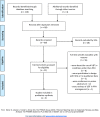Healthcare providers experiences of using uterine balloon tamponade (UBT) devices for the treatment of post-partum haemorrhage: A meta-synthesis of qualitative studies
- PMID: 33735300
- PMCID: PMC7971480
- DOI: 10.1371/journal.pone.0248656
Healthcare providers experiences of using uterine balloon tamponade (UBT) devices for the treatment of post-partum haemorrhage: A meta-synthesis of qualitative studies
Abstract
Background: Postpartum haemorrhage (PPH) is a leading cause of maternal mortality and severe morbidity globally. When PPH cannot be controlled using standard medical treatments, uterine balloon tamponade (UBT) may be used to arrest bleeding. While UBT is used by healthcare providers in hospital settings internationally, their views and experiences have not been systematically explored. The aim of this review is to identify, appraise and synthesize available evidence about the views and experiences of healthcare providers using UBT to treat PPH.
Methods: Using a pre-determined search strategy, we searched MEDLINE, CINAHL, PsycINFO, EMBASE, LILACS, AJOL, and reference lists of eligible studies published 1996-2019, reporting qualitative data on the views and experiences of health professionals using UBT to treat PPH. Author findings were extracted and synthesised using techniques derived from thematic synthesis and confidence in the findings was assessed using GRADE-CERQual.
Results: Out of 89 studies we identified 5 that met our inclusion criteria. The studies were conducted in five low- and middle-income countries (LMICs) in Africa and reported on the use of simple UBT devices for the treatment of PPH. A variety of cadres (including midwives, medical officers and clinical officers) had experience with using UBTs and found them to be effective, convenient, easy to assemble and relatively inexpensive. Providers also suggested regular, hands-on training was necessary to maintain skills and highlighted the importance of community engagement in successful implementation.
Conclusions: Providers felt that administration of a simple UBT device offered a practical and cost-effective approach to the treatment of uncontrolled PPH, especially in contexts where uterotonics were ineffective or unavailable or where access to surgery was not possible. The findings are limited by the relatively small number of studies contributing to the review and further research in other contexts is required to address wider acceptability and feasibility issues.
Conflict of interest statement
The authors have declared that no competing interests exist.
Similar articles
-
Provider experiences with uterine balloon tamponade for uncontrolled postpartum hemorrhage in health facilities in Kenya.Int J Gynaecol Obstet. 2015 Nov;131(2):201-4. doi: 10.1016/j.ijgo.2015.05.020. Epub 2015 Aug 5. Int J Gynaecol Obstet. 2015. PMID: 26277599
-
Cost-effectiveness of uterine balloon tamponade devices in managing atonic post-partum hemorrhage at public health facilities in India.PLoS One. 2021 Aug 18;16(8):e0256271. doi: 10.1371/journal.pone.0256271. eCollection 2021. PLoS One. 2021. PMID: 34407132 Free PMC article.
-
Provider experience of uterine balloon tamponade for the management of postpartum hemorrhage in Sierra Leone.Int J Gynaecol Obstet. 2016 Jul;134(1):83-6. doi: 10.1016/j.ijgo.2015.10.026. Epub 2016 Mar 21. Int J Gynaecol Obstet. 2016. PMID: 27085981
-
What matters to women and healthcare providers in relation to interventions for the prevention of postpartum haemorrhage: A qualitative systematic review.PLoS One. 2019 May 8;14(5):e0215919. doi: 10.1371/journal.pone.0215919. eCollection 2019. PLoS One. 2019. PMID: 31067245 Free PMC article.
-
Mechanical and surgical interventions for treating primary postpartum haemorrhage.Cochrane Database Syst Rev. 2020 Jul 1;7(7):CD013663. doi: 10.1002/14651858.CD013663. Cochrane Database Syst Rev. 2020. PMID: 32609374 Free PMC article.
Cited by
-
Successful use of condom catheters for management of uterine inversion: Case report and literature review.Int J Surg Case Rep. 2022 May;94:107076. doi: 10.1016/j.ijscr.2022.107076. Epub 2022 Apr 12. Int J Surg Case Rep. 2022. PMID: 35429784 Free PMC article.
-
A 3D-printed condom intrauterine balloon tamponade: Design, prototyping, and technical validation.PLoS One. 2024 Jun 11;19(6):e0303844. doi: 10.1371/journal.pone.0303844. eCollection 2024. PLoS One. 2024. PMID: 38861495 Free PMC article.
-
Midwives' experiences with aortic compression for postpartum hemorrhage: A qualitative study.Eur J Midwifery. 2023 Nov 23;7:35. doi: 10.18332/ejm/172880. eCollection 2023. Eur J Midwifery. 2023. PMID: 38023946 Free PMC article.
-
Assessing the potential for scaling evidence-based interventions in African health systems: A deliberate dialogue.Health Res Policy Syst. 2025 Jul 14;23(1):91. doi: 10.1186/s12961-025-01369-x. Health Res Policy Syst. 2025. PMID: 40660245 Free PMC article.
-
How inequity threatens the lives of pregnant women: barriers to accessing health services during an incomplete miscarriage in rural southern Mexico.BMJ Case Rep. 2022 May 23;15(5):e248819. doi: 10.1136/bcr-2022-248819. BMJ Case Rep. 2022. PMID: 35606027 Free PMC article.
References
-
- World Health Organization. Trends in maternal mortality 2000 to 2017: estimates by WHO, UNICEF, UNFPA, World Bank Group and the United Nations Population Division. Geneva: World Health Organization; 2019. Available at https://apps.who.int/iris/handle/10665/327596 [Accessed 5th September 2020].
-
- World Health Organization. WHO recommendations for the prevention and treatment of postpartum haemorrhage. Geneva: World Health Organization; 2012. Available at https://www.who.int/reproductivehealth/publications/maternal_perinatal_h... [Accessed 5th September 2020]. - PubMed
Publication types
MeSH terms
Grants and funding
LinkOut - more resources
Full Text Sources
Other Literature Sources
Miscellaneous


